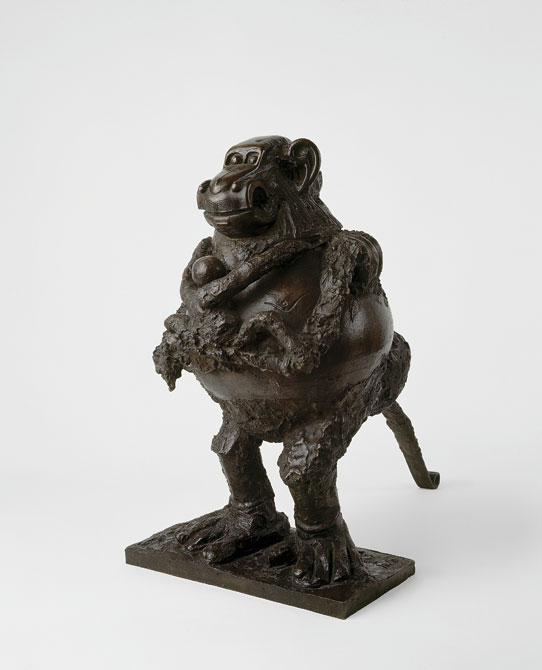Pablo Picasso - La guenon et son petit
La guenon et son petit, 1951
Bronze
53 x 33 x 61 cm
Sammlung Im Obersteg, Depositum im Kustmuseum Basel
Inv. Im 1414
Ausgestellt in der Ausstellung «Paarlauf» (Kunstmuseum Basel, Hauptbau, EG)
In 1943 Pablo Picasso met the young French painter Françoise Gillot. In 1947 their son Claude was born, in 1949 their daughter Paloma. The family lived in a villa called “La Galloise” in the small pottery village of Vallauris, near Cannes. “La Galloise” also served Picasso as an atelier. It was filled with found objects, among other things, with damaged, discarded pottery works by the village craftsmen that Picasso collected on his walks. His children often kept their father company while he was working. Life and art became very close. This is also noticeable in the bronze sculpture La guenon et son petit: the head of the baboon mother is made up of son Claude’s two toy cars – a Panhard and a Renault – which were fitted together, bottom to bottom. With two mini plaster balls, Picasso formed the eyes on the windshields of the Panhard and attached the handles of a clay pitcher to the sides to serve as protruding ears. He designed the body of the animal from a (most likely found) voluminous clay vessel, whose side handles perfectly portray the monkey’s shoulders. Finally, the iron fastening of a door or of a window shutter delineates the form of an animal’s tail lying straight behind. Legs and feet, etc., were made up of pieces of wood and worked-over plaster of Paris.
Picasso created his sculptures from different objects that he skillfully fitted together. He combined freehand modeling with the use of prefabricated, everyday objects, and in the era around 1950, the time when La guenon et son petit was produced, the high point of this innovative technique of assemblage was reached. The original is made of gypsum and can be found in the Musée Picasso in Paris. It was cast in bronze several times. Thus the sculpture in the Im Obersteg Collection is not one of a kind. Other bronze casts are to be found in New York and in the Picasso family.
Provenance
1953 erworben bei der Galerie Louise Leiris, Paris, von Karl Im Obersteg
Literature
Boeck 1955
Wilhelm Boeck: Picasso, Stuttgart: Kohlhammer, 1955, S. 291, 481, Nr. 240, Abb.
Russoli 1966
Franco Russoli: Picasso (Reihe: I maestri del colore), Mailand 1966, Abb. Tafel 11 (vermutl.
Penrose 1967
Roland Penrose: The Sculpture of Picasso, New York 1967, S. 29, 223, Nr. 108, Abb. S. 134
Dufour 1969
Pierre Dufour,:Picasso 1950-1968, Genf: Skira 1969, Abb. S. 42, 43
Spies 1983
Werner Spies: Picasso. Das plastische Werk: Werkverzeichnis der Skulpturen in Zusammenarbeit mit Christine Piot, Stuttgart: Verlag Gerd Hatje 1983, S. 251, 393, Nr. 463, Abb. S. 254, 255, 355
Baumgartner/von Tavel 1995
Michael Baumgartner und Hans Christoph von Tavel: Die Sammlung Karl und Jürg Im Obersteg, hrsg. von der Stiftung «Sammlung Karl und Jürg Im Obersteg», Bern, Bern: Benteli Verlag, 1995, S. 54, Nr. 9, Abb.
Exhibitions
Bern 1975
Sammlung Im Obersteg, bearb. von Hugo Wagner, hrsg. von Kunstmuseum Bern, 25. Juni-14. Sept. 1975, Nr. 69
Riehen 1980
Skulptur im 20. Jahrhundert, Wenkenpark, Riehen/Basel (Veranstalter: Ernst Beyeler und Gemeinde Riehen ), 10. Mai-14. Sept. 1980, hrsg. von Reinhold D. Hohl, Basel: Werner, 1980, Abb. S. 98
London 1994
Picasso: Sculptor/Painter, Tate Gallery, London, 16. Feb.-8. Mai 1994, London: ICON Colour und Tate Gallery Publications, 1994, S. 279-280, Nr. 120, Abb. S. 148
Bern 2001
Picasso und die Schweiz. Meisterwerke aus Schweizer Sammlungen, Kunstmuseum Bern, 5. Okt. 2001-6. Jan. 2002, Hrsg. Marc Fehlmann, Toni Stooss, Bern: Stämpfli, 2001, Nr. 144, Abb.
Wien 2003
Im Banne der Moderne: Picasso, Chagall, Jawlensky, BA-CA Kunstforum, Wien, 4. Sept.-30. Nov. 2003, Nr. 56
Basel 2004
Die Sammlung Im Obersteg im Kunstmuseum Basel. Picasso, Chagall, Jawlensky, Soutine, Kunstmuseum Basel, 14. Febr.-2. Mai 2004, hrsg. von der Stiftung Im Obersteg, Basel: Schwabe Verlag, 2004, Nr. 150
